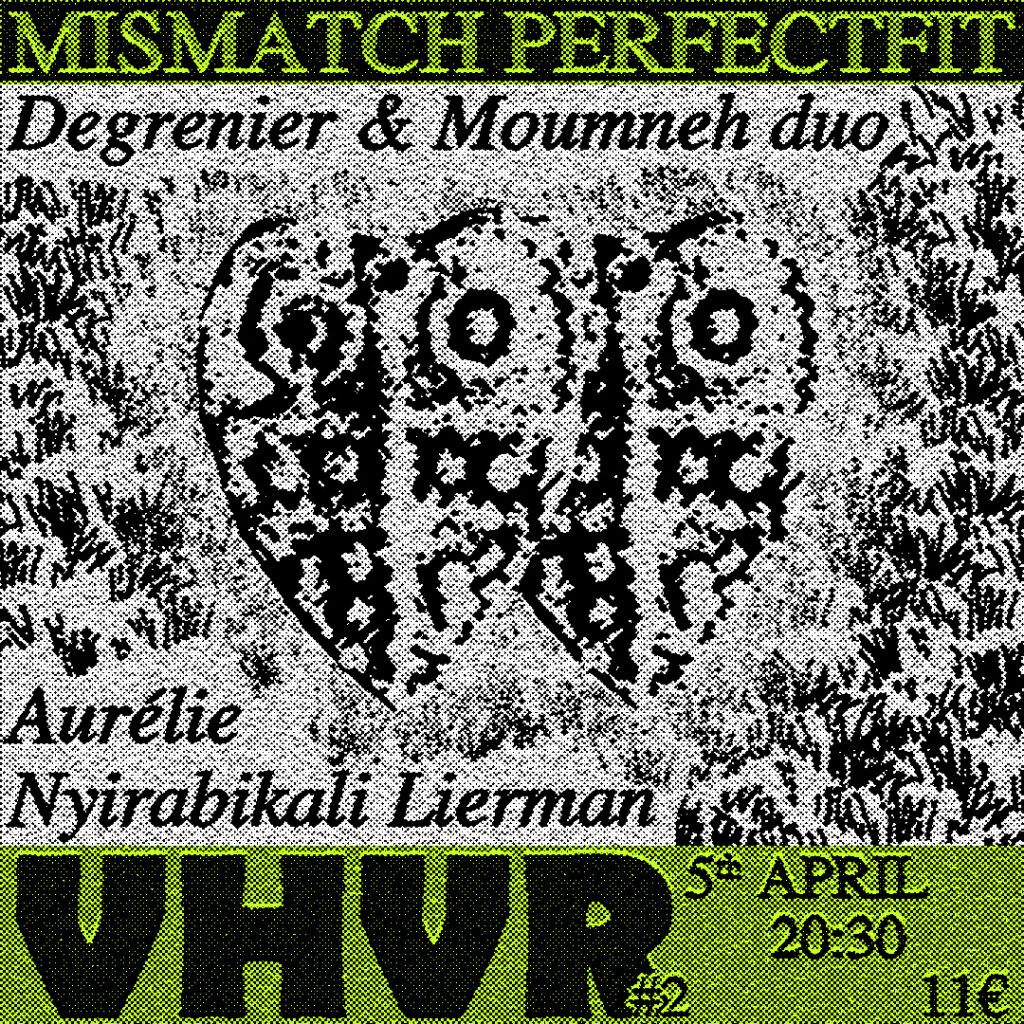VHVR #2 Degrenier & Moumneh duo, Aurélie Lierman

A Double Bill with 3 very interesting artists. Lierman will play her soundpiece Anosmia, maybe talk a bit about it -if the audience is open for that and also invited the Van Gennip Bookstore to show up with some assorted books, mainly about the Rwandian history.
For Alexis and Radwan, this is their first tour together and we’re very curious about what will happen. (great music we presume) Both acts will be in the middle of the room, surrounded by sound & audience.
Alexis Degrenier and Radwan Ghazi Moumneh
Great music from Alexis & Radwan; expect an intrinsic mix of deconstructed rhythms, electro-acoustics, Middle Eastern music and a spectacular ambient feel that resolves in a very personal way of dealing with all that stuff and still make a coherent and listenable result.
Creating a collaborative body of work, where we are deconstructing rhythm and meter from the opposing ends of each others musical heritage and constructing, re-constructing and writing new compositions.
Alexis Degrenier’s work is anchored in melodic rhythms that are delicately assembled to echo the minute and fragile at times, and the roaring and abrasive at others. Wed to melismatic vocalizations from Radwan Ghazi Moumneh and electronic compositions for Buzuk, Dvina and synthesizer, the two composers plan on diving deep into the realm of collaboration. The two composers have been exchanging ideas and philosophies over the past two years, and are excited at the prospect of this cross cultural collaboration, uniting ideas, methodology, technique and practice that each will bring to the table.
After studying classical percussion and composition, he decided to follow paths as vast as they are remote, invoking the music of G. Ligeti, the metric systems of the Maqam and Middle Eastern music, as well as the pulsations of everyday mechanics, and the music of Central France through the study of the oblique listening of sound spaces. He draws his inspiration from literature or philosophy to extract what he wishes to transform; a concept into affect. Alexis has serious health problems, he is also in a wheelchair and has been away from the stage for some years. His music echoes his own impediments, his body as a prosthesis and only base, the prosthesis as an extension of the body, created to constrain itself elsewhere, where repetition, accident, and the machine that becomes a new body member cohabit.
Alexis Degrenier: percussion, mechanical instruments, amplified objects, skins, resonators, stones, wood, friction, strokes, bodies, hands, circles and metronomes.
Radwan Ghazi Moumneh: buzuk, dvina, vocals, electronic synthesize.
Aurélie Nyirabikali Lierman
Pioneer of Afro-European radio art and musical theatre, Aurélie Nyirabikali Lierman’s work has been described as bold, provocative and delicate. She brings unique stories to life in an accessible and at the same time innovative way: often based on acoustic sounds and soundscapes that she moves around like a kind of cinema for the ears. She gathers all the sounds in her work herself during her many field recording expeditions to East-Africa. She collaborates with other artists in a variety of disciplines and fields and has won many prizes at home and abroad. www.aurelielierman.be/about
Programnotes Anosmia
This April it’s been exactly 30 years since the Rwandan Genocide: a civil war often shortlisted as one of the most brutal in history. The presentation of her tape piece Anosmia at Worm is Lierman’s contribution to this year’s worldwide commemoration in the Afro Diaspora.
“I still remember how, on April 7th 1994, an ordinary Thursday morning in Bruges, Belgium, I was walking down the stairs, just on my way out to school, when one of my parents approached me… Too much in total shock themselves to spare me any details. As a 14 year old I instantly wished I had nothing to do with Rwanda at all. Now, so many years later, obviously things have changed. I came to a point where I could no longer avoid that subject in my art. And that’s how I came to make Anosmia: a ca. 45 minute long radiophonic composition in which I reflect on the subject from a philosophical and artistic point of view.”
Anosmia is an abstract reflection zooming in on the absurd fact that a tiny part of the body, the nose, played a key role in the Rwandan Genocide. In the early 90’s Hutu extremists started broadcasting hate messages via public radio, against Tutsi people. Millions of Hutu moderates got manipulated and in April ‘94 the whole propaganda machinery escalated in a bloody civil war. For four long months, a whole nation was haunting ‘the enemy’, while often the enemy had to be found within oneself or one’s relatives. Distinguishing a ‘real Tutsi’ from a ‘real Hutu’ is rather difficult due to intermarriage. So during this period of war and terror tough decisions had to be made, often in no time: What if you were married to a Tutsi and had children with ‘enemy blood’? Back in ‘94 brutal killings within one family or household were countless! The length of a nose was decisive to classify the enemy. Even if your passport said ‘Hutu’; if you had a long and thin nose you were considered a ‘Tutsi’, so you would have had to hide or run for your life. Nowadays, in post-war Rwanda, it is by law forbidden to use the word ‘Tutsi’ or ‘Hutu’. Anosmia unfolds a fearless score which goes beyond taboos and classic aesthetics. Using spoken word, field recording, instrumental improvisation Lierman (BE/RW) sonically responds to the poem Politics Of The Nose written by David Mwambari (RW), echoing the Rwandan Genocide in 1994. https://aurelielierman.be/anosmia/